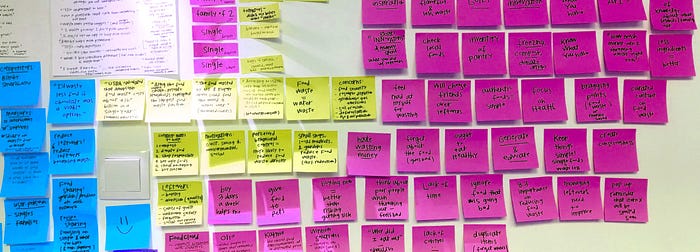Mastering Affinity Mapping in UX Design: A Comprehensive Guide
Written on
Understanding Affinity Mapping
The term 'affinity' refers to the underlying principle of connecting related topics, themes, or issues. 'Mapping' involves analyzing these linked items to uncover patterns, themes, and trends. Every UX designer has likely been tasked with presenting an affinity map as a demonstration of their skills. This technique stands out as one of the most effective tools in our UX toolkit.
However, affinity mapping transcends mere sticky notes; it represents a precise and honest distillation of data, revealing trends and themes that surface from thorough research efforts. Topics covered in affinity mapping can include users' positive experiences as well as pain points, frustrations, misunderstandings, and areas needing improvement in subsequent product iterations.
Affinity mapping is both strategically and creatively crucial. You may have encountered the familiar sight of an affinity map, often characterized by colorful sticky notes plastered on various surfaces.
Let’s delve into five key insights that illuminate why affinity mapping is such a valuable tool in UX design.
Organizing Techniques
Gather your vibrant, multi-colored sticky notes for this process. Affinity mapping thrives on the utilization of these notes, which come in various sizes and colors. A Sharpie is the pen of choice for jotting down brief, impactful notes.

Additionally, digital sticky notes can be created using online platforms like Google Jamboard or Figma's FigJam. Google Jamboard offers a user-friendly interface with several frames and tools, although it has a size limitation.
Example A: A collection of sticky notes displayed on a white wall, captured by Hugo Rocha on Unsplash.
Example B: A layout of digital sticky notes on Google Jamboard, showcasing insights from five participant interviews.
Example B2: An illustration of sticky notes on Figma FigJam, presenting insights from the same interviews.
Research Foundations
It’s crucial to recognize that affinity mapping relies heavily on research insights. Without conducting interviews, collecting data, or observing user behavior, the affinity mapping process cannot commence.
Ensure your research is well-organized, gathering results from at least five participant interviews. Each participant should undertake multiple tasks using your prototype, allowing for various prompts depending on your project.
Example C: A template of a spreadsheet for documenting interview data, including tasks, click paths, observations, quotes, and completion metrics.
Each participant should have a dedicated page where you note task prompts, observations, quotes, and feedback on task difficulty.
Transferring Insights to Sticky Notes
A pivotal secret to effective affinity mapping is assigning each participant a specific color for their sticky notes. This ensures clarity and organization in the feedback process.
Example D: An expanded board in Figma FigJam featuring feedback sticky notes from five interview participants, each represented by their unique color.
At this stage, the data remains unorganized and has yet to be 'mapped' or analyzed.
Categorizing Themes and Trends
The team can now assess the sticky notes collected from all participants. Ideally, every observation and piece of feedback should be noted. The notes are grouped by affinity, with similar insights combined under thematic headers.
Example E: Sticky notes grouped by similarity, with themes clearly labeled at the top of each category.
This grouping allows for an analysis of participants' collective voices, revealing common struggles. For instance, if five participants faced issues with text legibility, generic headers, or content sharing functionality, these pain points highlight areas for improvement.
Writing Research Findings
Once the affinity map is established, you can articulate clear statements based on the research metrics. For example, "4 out of 5 participants requested..." illustrates the insights derived from the mapping process.
Example F: Metrics such as "4 out of 5 participants asked for…” based on the insights gathered, with a focus on prioritizing critical findings for further iterations.
In summary, affinity mapping is an essential UX tool for identifying the themes and challenges faced by research participants. It should only follow a substantial amount of research data collected through user interviews and data analysis.
Many resources are available for creating an affinity diagram, from physical sticky notes to cloud-based whiteboards and digital layout programs. Collaborative efforts within the UX team can foster creativity and diverse outcomes, although an individual designer can also undertake this task. Sharing the work with the broader team remains crucial in UX.
Thank you! ✍️🧡
Illustrations ©Eva Schicker 2022.
Image credit: Photo by Hugo Rocha on Unsplash
References:
[1] Affinity Mapping:
[2] UX Research methods:
Links:
The first video, "Affinity Mapping: A Simple Tool for Organizing User Feedback," offers a comprehensive overview of how to utilize affinity mapping in user research.
The second video, "How to Create an Affinity Map," provides step-by-step guidance on setting up your affinity mapping process effectively.